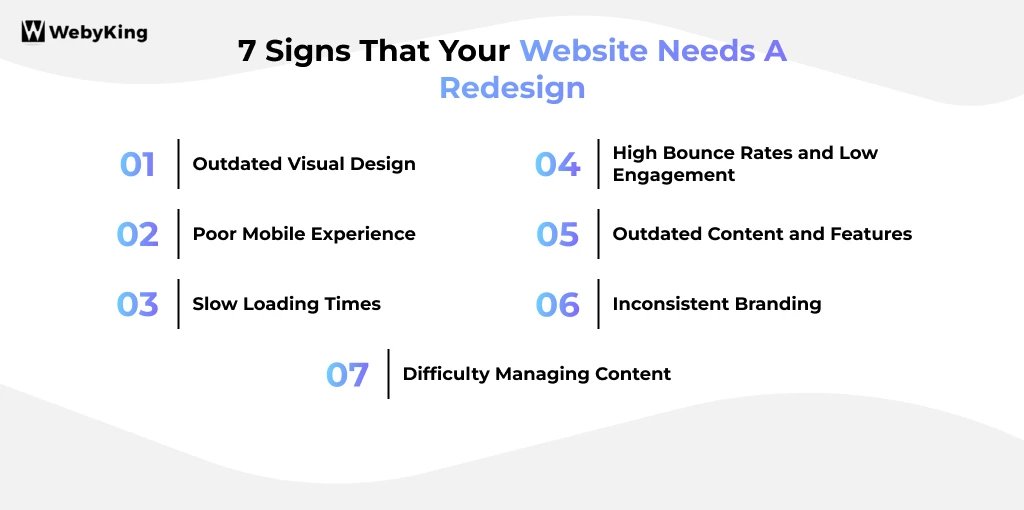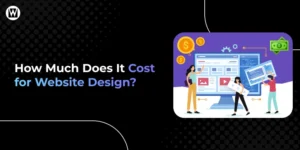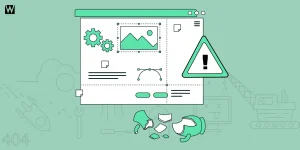The Complete Website Redesign Guide: Recognize the Signs, Understand the Timelines, and Succeed

Is your website helping your business, or holding you back?
Your website is often the first thing customers see—and in seconds, it can make a strong first impression or drive people straight to your competitors. In today’s fast-paced digital world, it’s not enough to just “have” a website. Keeping it up-to-date is a must.
A smart redesign does more than just improve appearances—it can make your site easier to use, match your current business goals, and help you stay ahead of the competition.
But how do you know it’s time for an update? And how often should you refresh your site to stay relevant? In this guide, we’ll walk you through the clear signs, industry standards, and simple strategies to help you determine when and how to upgrade your website without breaking the bank.
What is a Website Redesign?
A website redesign is the strategic process of overhauling your site’s visual appearance, structure, and functionality to better align with evolving business goals, user expectations, and technological advancements.
It’s far more than just a fresh coat of paint – modern web redesign projects often address user experience, mobile responsiveness, site speed, SEO, and brand consistency, ensuring your online presence remains competitive and engaging.
For example, brands like Airbnb and Dropbox have famously transformed their digital identities through strategic website redesign examples, resulting in improved usability, strong brand recognition, and higher conversion rates.
A successful website redesign streamlines content management, enhances features, and creates a cohesive brand experience, ultimately helping businesses attract more visitors, boost credibility, and drive growth in today’s fast-paced digital landscape.
The Signs That Your Website Needs A Redesign
Knowing how often you should redesign your website can be tricky, but certain clear signs indicate when it’s time for a fresh start. Paying attention to these signals helps you avoid common website design mistakes and ensures your site stays effective, user-friendly, and aligned with your goals.

Outdated Visual Design
If your website looks like it belongs to a past decade, it’s time for a website redesign. Modern users expect clean, visually appealing sites that load quickly and reflect current design trends.
An outdated look can make your business seem behind the times and less trustworthy, which may drive potential customers to competitors with fresher, more engaging websites.
Poor Mobile Experience
With mobile traffic now dominating the web, a site that isn’t mobile-friendly or responsive is a major red flag. If your landing page design or other key pages don’t adapt smoothly to smartphones and tablets, users will likely abandon your site in frustration.
A seamless mobile experience is crucial for capturing and retaining today’s on-the-go audience.
Slow Loading Times
Nobody likes waiting for a website to load. If your pages take more than a few seconds to appear, you’re losing visitors and damaging your search engine rankings.
Slow sites often result from outdated code, unoptimized images, or overloaded servers – issues that a professional website redesign service can address to deliver a faster, smoother user experience.
High Bounce Rates and Low Engagement
If your analytics show that visitors are leaving quickly or not interacting with your content, your site may not be meeting their needs or requirements.
High bounce rates can stem from confusing navigation, cluttered layouts, or irrelevant information. Redesigning your site with a focus on user experience and a clear call-to-action can boost engagement and conversions.
Outdated Content and Features
A website that hasn’t been updated regularly is likely missing essential features or displaying stale information.
For example, if you don’t offer online booking, chat support, or updated product listings, you’re not serving your customers effectively. Remember, how often the website’s home page gets refreshed can impact both user trust and SEO performance.
Inconsistent Branding
Your website is a reflection of your brand. If your logos, colors, fonts, or messaging don’t match your current branding, it creates confusion and weakens your identity. A redesign can unify your online presence, ensuring every element is consistent and reinforces your brand story.
Difficulty Managing Content
If updating your website feels like a chore due to an outdated CMS or complex backend, it’s time to rethink your approach. A modern website redesign can streamline content management, making it easy for your team to keep the site fresh, relevant, and aligned with your business goals, without technical headaches.
By watching for these challenges as they arise, you can take action before they start holding your business back. Recognizing these signs early helps you plan your next website redesign strategically, ensuring your site remains a powerful tool for attracting and engaging your audience.
Don’t let an outdated site cost you customers. Let’s help you create a modern, high-performing website that reflects your brand and converts visitors into leads.
The Average Website Redesign Timeline: Industry Benchmarks
The timeline for a website redesign can vary widely depending on your site’s size, complexity, goals, and available resources. Understanding industry benchmarks and the typical phases involved helps set realistic expectations and ensures a smoother project from start to finish.
Key Factors Influencing Website Redesign Timelines
- Website Size & Complexity: More pages, features, or integration means longer timelines.
- Project Scope: A simple refresh takes less time than a full rebrand or major feature overhaul.
- Team & Resources: An experienced, well-staffed team can accelerate the process.
- Stakeholder Involvement: Multiple decision-makers or unclear feedback can cause delays.
- Testing & Launch: Thorough QA and user testing are critical and can extend timelines.
Typical Website Redesign Timeline by Site Size
Some agencies use a growth-driven design approach, launching a minimum viable product quickly and iterating based on real-time data. This can shorten initial launch times and spread improvements over several months.
The Website Redesign Process: From Planning To Relaunch
A successful website redesign doesn’t happen overnight – it’s a strategic process that moves from thoughtful planning to a seamless relaunch. Here’s a breakdown of the website redesign journey, step by step:
1. Goal Setting
The foundation of any successful website redesign is clear, measurable goals. What do you want your new website to accomplish? Whether it’s increasing online sales, improving mobile usability, or better reflecting your brand identity, defining these objectives upfront guides every decision moving forward.
For instance, when Slack redesigned its website, its primary goal was to simplify the user onboarding experience and highlight key product features more effectively. This focus helped them increase user engagement and sign-ups significantly after launch.
2. Site Audit
Before diving into design, conduct a thorough audit of your current website. Analyze traffic patterns, bounce rates, page load speeds, and conversion metrics using tools like Google Analytics and Hotjar.
This helps identify which pages perform well and which need improvement or removal. HubSpot reports that 43% of users abandon websites due to poor design or slow loading, so pinpointing these issues early is important.
Additionally, check for outdated content, broken links, and SEO weaknesses. A detailed audit lays the groundwork for a smarter redesign that builds on existing strengths and fixes critical flaws.
3. User Research
Understanding your audience is key to designing a website that truly resonates. Conduct surveys, interviews, and usability tests to gather insights into user preferences, pain points, and behaviors.
Airbnb’s redesign is a great example of user research shaping design decisions—they discovered users wanted a more intuitive booking process and richer visual storytelling, which led to a more engaging and streamlined experience.
4. Content Planning
Content is the heart of your website. During this phase, decide what content to keep, update, or remove based on relevance and performance.
Organize your content into a clear, logical structure that supports user journeys and business goals. This is also the time to plan new content that addresses gaps or emerging trends.
Effective content planning not only improves usability but also strengthens your SEO, helping your site rank better and attract more organic traffic.
5. Wireframes and Mockups
Wireframes serve as the blueprint for your new site, outlining the layout and placement of key elements without distractions from colors or images. They help visualize the user flow and functionality early in the process. Once wireframes are approved, designers create detailed mockups incorporating your brand’s colors, fonts, and imagery.
Dropbox, for example, shares early wireframes with stakeholders to gather feedback and make quick adjustments, speeding up the design cycle. This step ensures everyone is aligned on the look and feel before development begins.
6. Design & Branding
This phase brings your site’s personality to life. Designers create a visually cohesive experience that reflects your brand identity and appeals to your target audience. Incorporating branding services at this stage ensures the entire look and feel is unified and strategic.
According to Lucidpress, consistent branding across all channels can increase revenue by up to 23%. This underscores just how important it is to present a unified look everywhere your brand appears.
From typography and color schemes to imagery and iconography, every detail should reinforce your brand story and help build an emotional connection with visitors.
7. Development
Here, the design transforms into a fully functional website. Developers build responsive layouts that adapt seamlessly to all devices, and integrate necessary features like contact forms or eCommerce capabilities, and optimize the site speed and security.
This technical phase also involves migrating existing content and ensuring compatibility with browsers and platforms. A smooth development process is vital for delivering a polished, high-performing site that meets modern standards.
8. Testing & Quality Assurance
Before launch, rigorous testing is essential to catch bugs, broken links, and usability issues. Test across multiple devices and browsers to ensure consistent performance.
User acceptance testing (UAT) involves real users navigating the site to identify any friction points. Amazon, known for its testing, credits this process for its industry-leading conversion rates and customer satisfaction. Addressing issues before launch prevents costly fixes later and ensures a flawless user experience from day one.
9. Launch
The big day! Launching your redesigned website involves more than flipping a switch – it requires careful coordination to minimize downtime and preserve SEO rankings.
Announce the relaunch through email campaigns, social media, and other marketing channels to generate excitement and drive traffic. Monitor site performance closely during the first few weeks to quickly resolve any unexpected issues.
A successful relaunch sets the stage for ongoing growth and engagement.
10. Post-launch Review & Maintenance
A website redesign isn’t a one-and-done project. After launch, collect user feedback and analyze performance metrics to identify areas for improvement. Continuing optimization based on real feedback helps your site evolve with changing user needs and industry trends.
Many successful brands treat their websites as living assets, regularly updating content, features, and design elements to stay competitive and relevant.
Still unsure if it’s time for a redesign? Our team can walk you through the best approach based on your current site and goals—no pressure, just expert guidance.
Final Thoughts
Finally, redesigning your website every two to three years can help you stay one step ahead in the competition. If your competitors have recently updated their website and you haven’t, you could be falling behind.
A website built with a modern design and technology doesn’t just look better – it performs better. If your site still reflects the standard from 10 years ago, you’re not just outdated – you’re losing customers. Stay ahead of the curve with a site that’s fast, responsive, and built for today’s users – or risk being left behind.
A website redesign can help you stay on top of the emerging trends and ensure that your website meets your customers’ needs. Now that you know, contact WebyKing. Let’s talk about your new website redesign.
FAQs on Website Downtime Cost
How often should a business redesign its website?
On average, businesses should consider a redesign every 2-3 years to keep up with design trends, tech updates, and user expectations.
What are the signs that my website needs a redesign?
Slow load times, outdated design, poor mobile experience, and declining traffic are strong indicators that it’s time for a redesign.
Does a website redesign help with SEO?
Yes, if done right. A redesign can improve site speed, mobile usability, and structure- all key SEO factors.
Can I update my website without a full redesign?
Yes, small changes like updating content, images, or layout tweaks can help temporarily, but may not solve deeper UX or performance issues.
How much does it cost to redesign a website?
The average cost of a professional website redesign usually falls between $2,000 and $15,000 or more. The exact price depends on several factors, like how large your site is, how complex the features are, and what integrations or special design elements you want.

Ravi Makhija, the visionary Founder and CEO of WebyKing, is a seasoned digital marketing strategist and web technology expert with over a decade of experience. Under his leadership, WebyKing has evolved into a premier full service web and marketing agency, delivering innovative solutions that drive online success. Ravi’s deep understanding of the digital landscape combined with his passion for cutting-edge technologies empowers him to consistently exceed client expectations and deliver results that matter.














